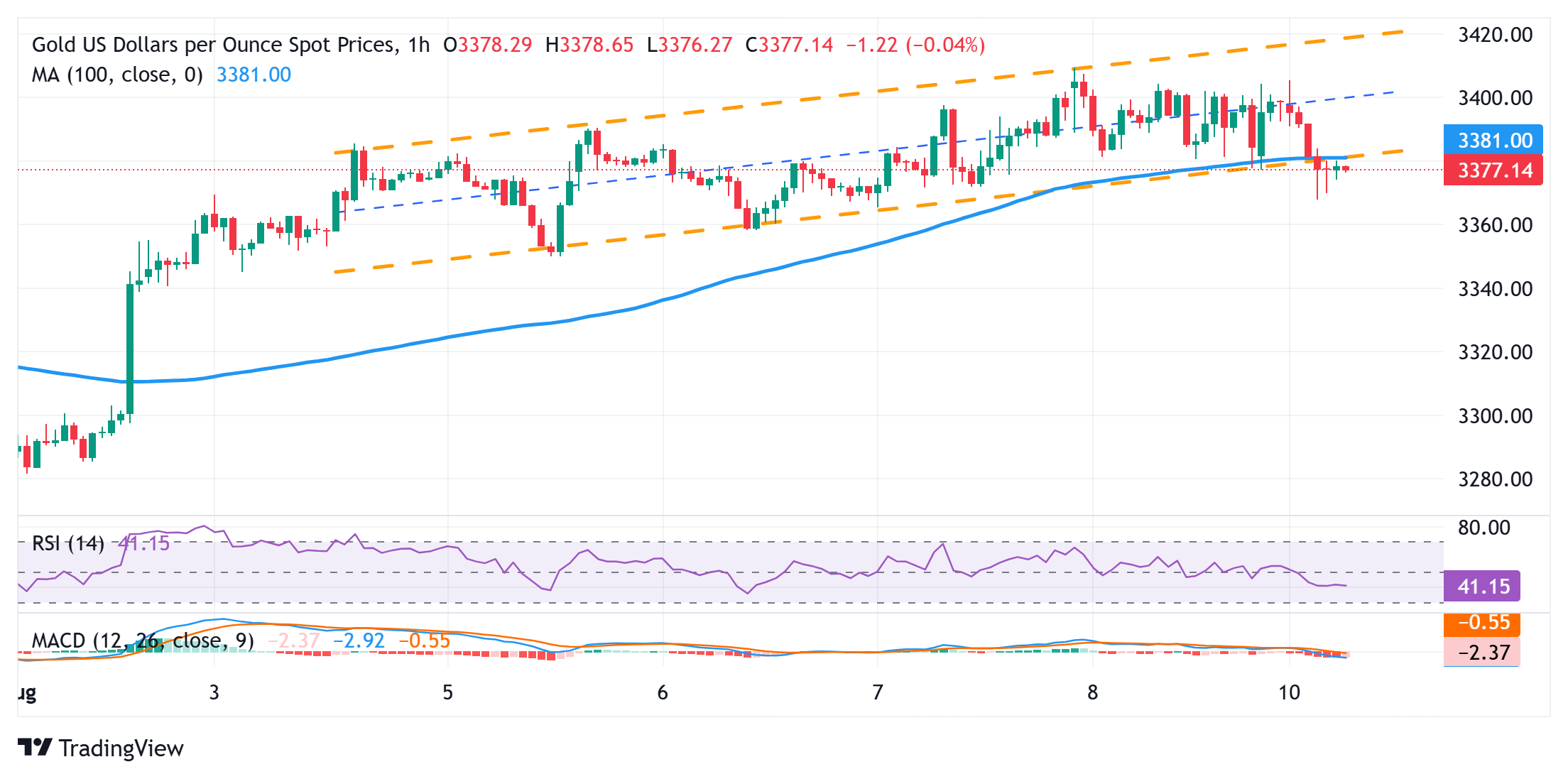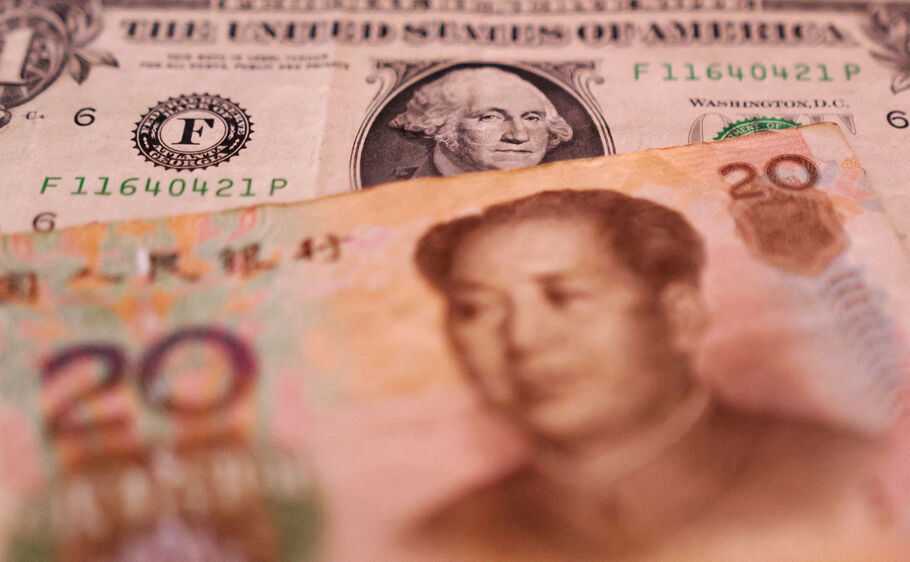Gold price declines amid risk-on sentiment despite Fed rate cut expectations

- Gold price kicks off the new week on a weaker note, while a positive risk tone undermines safe-haven assets.
- Rising Fed rate cut bets prompt fresh USD selling and offer some support to the non-yielding yellow metal.
- Traders now look forward to the release of US inflation figures this week to determine the near-term trajectory.
Gold price (XAU/USD) continues with its struggle to find acceptance above the $3,400 mark and attracts heavy selling during the Asian session on Monday. The sharp intraday fall is sponsored by a positive risk tone, which tends to undermine demand for the traditional safe-haven bullion. However, a combination of factors holds back traders from placing aggressive bearish bets and assists the precious metal to rebound slightly from the $3,368-3,367 region.
Persistent trade-related uncertainties ahead of the looming US tariff deadline on China, which is due to expire on Tuesday, keep investors on edge. Moreover, bets that the Federal Reserve (Fed) will cut interest rates more than previously expected prompt fresh US Dollar (USD) and help limit losses for the non-yielding Gold price. Adding to this, nervousness heading into the US-Russia bilateral talks on Ukraine offers some support to the XAU/USD pair.
Daily Digest Market Movers: Gold price drifts lower as receding safe-haven demand offsets weaker USD
- Asian stock markets and US equity futures rose at the start of a new week amid hopes that a meeting between US and Russian leaders will increase the chances of ending the war in Ukraine. This, in turn, prompts heavy selling around the safe-haven Gold price at the start of a new week.
- However, the uncertainty over the US-China tariff truce, which is due to expire on August 12, lends some support to the precious metal. Adding to this, rising Federal Reserve rate cut bets and the emergence of fresh US Dollar selling help limit losses for the non-yielding yellow metal.
- Investors seem convinced that the US central bank will resume its rate-cutting cycle in September and deliver at least two 25-basis-point rate cuts by the end of this year. The expectations were lifted by the July Nonfarm Payrolls report, which pointed to a deteriorating US labor market.
- Meanwhile, St. Louis Fed President Alberto Musalem said last Friday that there is a risk that the US central bank may miss on both inflation and employment, with downside risk to jobs. Musalem further added that most of the impact of tariffs on inflation will likely fade.
- Separately, Fed Governor Michelle Bowman said on Saturday that the latest weak labor market data underscores her concerns about labor market fragility and strengthens her confidence in her forecast that three interest rate cuts will likely be appropriate this year.
- Investors this week will confront the release of the US inflation figures – the Consumer Price Index (CPI) on Tuesday and the Producer Price Index (PPI) on Thursday. This, along with speeches from influential FOMC members, will drive the USD and the XAU/USD pair.
Gold price seems vulnerable to slide further below short-term ascending channel

Monday's intraday downfall drags the Gold price below the $3,382 confluence – comprising the 100-hour Simple Moving Average (SMA) and the lower boundary of a short-term ascending channel. Furthermore, oscillators on the said chart have been gaining negative traction and back the case for a further depreciating move. That said, positive technical indicators on 4-hour/daily charts suggest that any subsequent slide is more likely to find decent support near the $3,353-3,350 area. A convincing break below, however, will be seen as a fresh trigger for bearish traders and makes the XAU/USD pair vulnerable to accelerate the slide towards the $3,315 intermediate support en route to the $3,300 round figure.
On the flip side, the $3,400 mark might continue to act as an immediate strong barrier and cap any attempted recovery. That said, some follow-through buying beyond last week's swing high, around the $3,409-3,410 area, would negate the negative outlook and lift the Gold price to the next relevant hurdle near the $3,422-3,423 area. The momentum could extend further towards the $3,434-3,435 strong horizontal barrier. A sustained strength beyond the latter should pave the way for a move towards challenging the all-time peak, around the $3,500 psychological mark touched in April.
Risk sentiment FAQs
In the world of financial jargon the two widely used terms “risk-on” and “risk off'' refer to the level of risk that investors are willing to stomach during the period referenced. In a “risk-on” market, investors are optimistic about the future and more willing to buy risky assets. In a “risk-off” market investors start to ‘play it safe’ because they are worried about the future, and therefore buy less risky assets that are more certain of bringing a return, even if it is relatively modest.
Typically, during periods of “risk-on”, stock markets will rise, most commodities – except Gold – will also gain in value, since they benefit from a positive growth outlook. The currencies of nations that are heavy commodity exporters strengthen because of increased demand, and Cryptocurrencies rise. In a “risk-off” market, Bonds go up – especially major government Bonds – Gold shines, and safe-haven currencies such as the Japanese Yen, Swiss Franc and US Dollar all benefit.
The Australian Dollar (AUD), the Canadian Dollar (CAD), the New Zealand Dollar (NZD) and minor FX like the Ruble (RUB) and the South African Rand (ZAR), all tend to rise in markets that are “risk-on”. This is because the economies of these currencies are heavily reliant on commodity exports for growth, and commodities tend to rise in price during risk-on periods. This is because investors foresee greater demand for raw materials in the future due to heightened economic activity.
The major currencies that tend to rise during periods of “risk-off” are the US Dollar (USD), the Japanese Yen (JPY) and the Swiss Franc (CHF). The US Dollar, because it is the world’s reserve currency, and because in times of crisis investors buy US government debt, which is seen as safe because the largest economy in the world is unlikely to default. The Yen, from increased demand for Japanese government bonds, because a high proportion are held by domestic investors who are unlikely to dump them – even in a crisis. The Swiss Franc, because strict Swiss banking laws offer investors enhanced capital protection.






